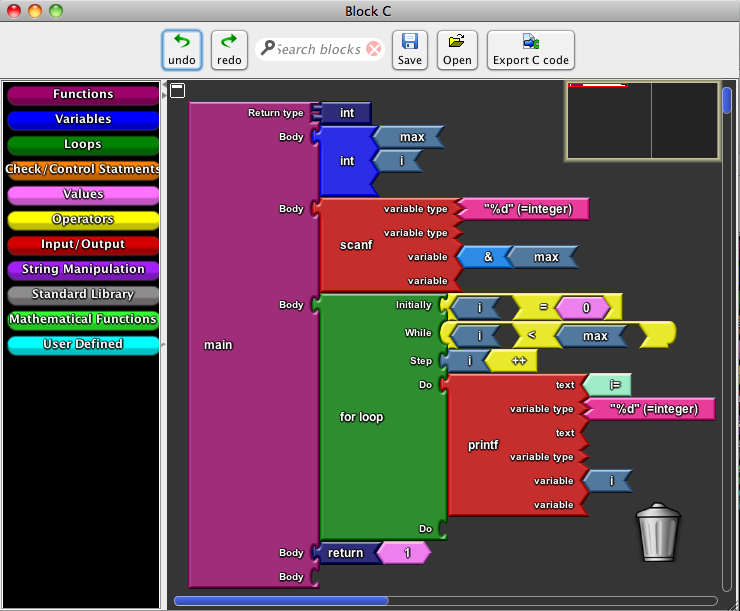
Block-C is an editor for C programming language which uses visual blocks as
for writing programs.
It was created from scratch as part of my undergraduate thesis.
The problem BLock-C was designed to solve, was the difficulty that first
year students face when are first introduced to C language.
Block-C was designed to help them focus on the logic of programming
instead of the cumbersome syntax of C.
Design
Block-C was designed based on 4 design principles:
-
Interaction with understandable concepts: Learners should not be expected to manipulate readily resources or tokens which cannot be easily understood such as libraries and the corresponding #include precompiler directive.
-
Syntactic error prevention: Syntax guidance should be given for the formation of correct C language expressions in a way that eliminates syntactic errors. This is accomplished by the use of visual blocks that make explicit the structure of language expressions. Furthermore, a restricted sub-grammar is used having only the necessary to introduce a novice to C programming.
-
Beautified code: Guide learners to writing well-structured code employing automatically paired parentheses, brackets, code block limits etc. This is accomplished through the use of graphical blocks.
-
Transitivity of the tool: Enable the learners to move from Block−C to ordinary textual C programming. Block−C translates block−based code to C plain text code and provides both viewing options. This way, it promotes the understanding of the correspondence between the command blocks and the actual C statements and their syntax.

Evaluation
Block-C was evaluated in 3 independent stages;
a think aloud evaluation with novices, a think aloud evaluation with
experts and one final controlled experiment evaluation with 32 novices.
Between these stages the user interface was refined based on the feedback
of each evaluation.
Initial evaluation with novices
The goal of this evaluation was to address the novice users’
perspective and identify usability flaws.
Three university students volunteered to evaluate the interface.
A think-aloud protocol was used and the participants
were asked to accomplish a set of twelve tasks of gradual
difficulty. At the end of the evaluation session the
users completed a questionnaire.
Some major usability errors and bugs were detected and subsequently solved.
Moreover, the users suggested some extra functionality which was
implemented in the second prototype of the tool.
Evaluation with experts
The purpose in this stage was to get feedback from
experienced C programming academic teachers.
Three lecturers
from the department of Electrical and Computer Engineering of
the Technical University of Crete participated in the experiment.
The participants were asked to use
Block−C and compose a simple C program. During the
interview they were asked to explain the difference of some
similar syntactic tokens (e.g. assignment operator “=” vs.
equality testing operator “==”) using the block commands. They
were also asked to reflect on how they would explain the
differences of blocks and its connectors to their students.
The results of this evaluation helped in further discover major
interface problems. Several bugs were detected and fixed, as
well. Furthermore, the users contributed in the addition of extra
functionality.
Final Evaluation of Effectiveness
This stage aimed at evaluating the learning effectiveness of Block−C following controlled group experimentation, with the test group used Block−C while the control group used plain text C.In total 32 first-year students participated. The participants were randomised in control and test group. The evaluation procedure was organized in two sessions.
The first session was introductory and participants of both groups were introduced to the environments used and asked to solve a set of exercises with the help of tutors.
The second stage was the actual evaluation and the participants were asked to solve three tasks of increased difficulty in two hours. Four tutors were present to help participants only with significant logical errors and not syntactical.
Results
Accoring to the results, with the use of Block-C 1.3, 1.8 and 3 times more participants finished the 1st the 2nd and the 3rd task respectively.
The participants of the test roup
were also asked about the emotions the had during the
use evalaution and asked to complete the emotional response scale.
Almost all of them had a pleasant or a neutral emotion, as presented in
Figure 4.

At the end of the semester and after the examination period,
the participants of the test group (Block-C) were asked about
their opinion about Block-C retrospectively.
All participants (both those who passed the course and those
who fail) thought that Block-C was useful in helping them
learn C, thought that Block-C was effective and were
positive about suggesting Block-C to other novices.
This work has been published in 2017 IEEE Global Engineering Education Conference (EDUCON) and 9th International Conference “New Horizons in Industry, Business and Education” (NHIBE 2015).


